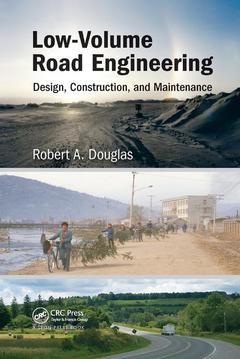Low-Volume Road Engineering Design, Construction, and Maintenance
Auteur : Douglas Robert A.

"Everything that sustains us ? grown, mined, or drilled ? begins its journey to us on a low-volume road (Long)." Defined as roads with traffic volumes of no more than 400 vehicles per day, they have enormous impacts on economies, communication, and social interaction. Low-volume roads comprise, at one end of the spectrum, farm-to-market roads, roads in developing countries, northern roads, roads on aboriginal lands and parklands; and at the other end of the spectrum, heavy haul roads for mining, oil and gas, oil sands extraction, and forestry.
Low-Volume Road Engineering: Design, Construction, and Maintenance
Topics covered include the following:
- Road classification, location, and geometric design
- Pavement concepts, materials, and thickness design
- Drainage, erosion and sediment control, and watercrossings
- Slope stability
- Geosynthetics
- Road construction, maintenance, and maintenance management
Low-Volume Road Engineering: Design, Construction, and Maintenance i
Introduction to Low-Volume Roads. Road Location. Road Classification. Geometric Design. Pavement Concepts. Pavement Materials. Pavement Design. Drainage. Soil Erosion and Sedimentation Control. Watercourse Crossings. Slope Stability. Geosynthetics. Road Construction. Road Maintenance. Pavement Maintenance and Rehabilitation Management.
Robert Douglas has over thirty five years' experience in low-volume road engineering consulting, teaching and research. He has been a senior geotechnical engineer with an international consulting firm, and on the academic staff of forest engineering programs at the University of New Brunswick, Canada and at the National School of Forestry at the University of Canterbury, Christchurch, New Zealand.
Date de parution : 07-2017
15.6x23.4 cm
Date de parution : 01-2016
15.6x23.4 cm
Thèmes de Low-Volume Road Engineering :
Mots-clés :
Chip Seal; Low-Volume Roads; Gr Av; LVR; Asphalt Cement; Road Design; Pe Rc; Road Location Process; Low Volume Road; Water Crossings; Pavement Structure; Degree of Horizontal Curvature; Fe Nc; Geometric Design; Silt Fence; Design Vehicles; Subgrade Soil; Haul Roads; MTO; Stopping Sight Distance; Horizontal Curvature; Coefficient of Side Friction; Si Te; Maximum Superelevation; Horizontal Curves; Moisture Content; Spiral Transition Curves; Skidding Resistance; Lateral Clearance; Subgrade Strength; Cleared Right of Way Width; ESAL; Railway Crossings at Grade; Agriculture Forest Service; Minimum Gradient; Asphalt Cement Content; Maximum Gradient; Rain Drop; Critical Length of Grade; Transportation Association; Crest Vertical Curves; Av Em; Sag Vertical Curves; Rigid Pavements; Cross-Sectional Elements; Pavement Design Methods; One-Lane; Two-Way Roads; Eri Ca; Road Cross Section Components; Pavement Structures; Pavement Load-Carrying Mechanisms; Soil Tests; Soil Classification; Tests of Aggregates; Subgrade Soil Stabilization Materials; Chip Seals; Roller-Compacted Concrete; Pavement Design; U.S; Mechanistic-Empirical Design Method; Surface Drainage; Internal Drainage; Frost; Permafrost; Pumping and Potholes; Soil Erosion Process; Erosion Control; Sedimentation Control; Hydrology; Fords and Low-Water Crossings; Bridges; Crossing Wetlands; Watercourse Crossing Location; Plane Translational Failures; Circular Failures; Methods of Slices; Bishop’s Modified Method of Slices; Geosynthetics; Earthwork Volume Calculations; Concrete Pavements; Surface-Treated Pavements; Gravel- and Earth-Surfaced Roads; Pavement Maintenance and Rehabilitation Management System; Pavement Management System (PMS); Asphalt Pavements; Culverts; Asphalt Concrete



